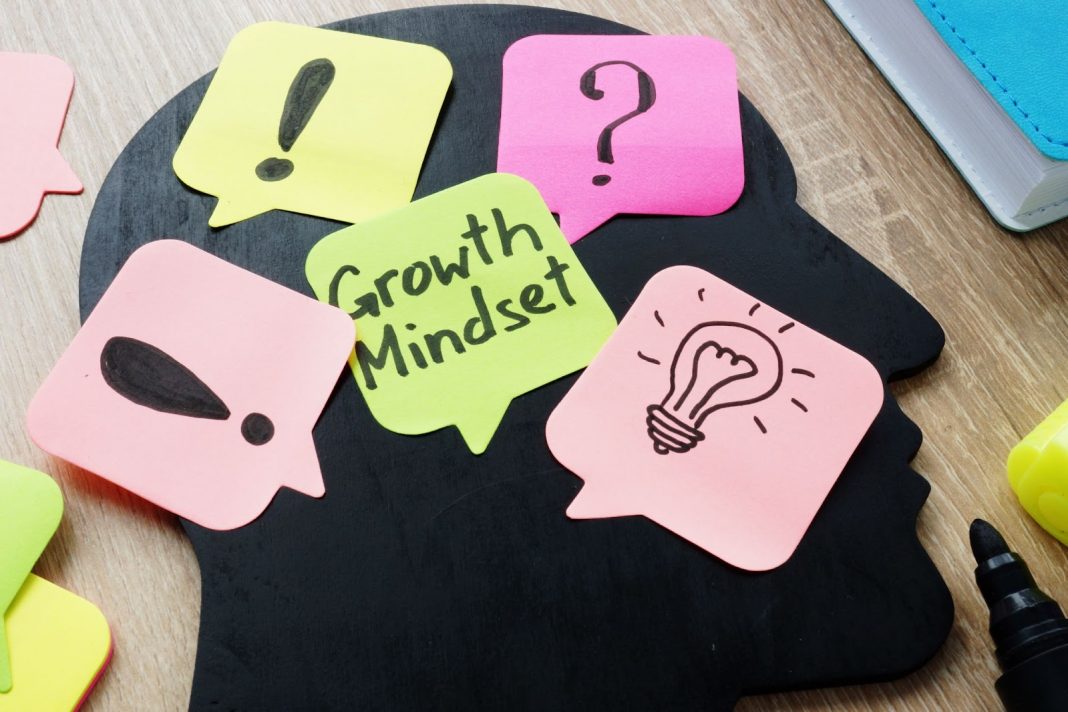- 1. Create a Growth Mindset Vision Board
- 2. Growth Mindset Worksheet
- 3. The Growth Mindset Story Narration
- 4. Growth Mindset Story Cubes
- 5. Obstacle Course Challenge
- 6. Goal Achievement Charts
- 7. Growth Mindset Coloring Book
- 8. Positive Post-It Notes
- 9. Growth Mindset Art Gallery
- 10. Mistake Reflection Journal
“The only limit to our realization of tomorrow will be our doubts of today.” — Franklin D Roosewelt
Cultivating a growth mindset plays a pivotal role in overcoming this “self-doubt”. Just as physical growth is nurtured through proper care and nutrition, fostering a growth mindset involves engaging in growth mindset activities that cultivate resilience, perseverance, and a belief in the potential for improvement.
Math & ELA | PreK To Grade 5
Kids see fun.
You see real learning outcomes.
Watch your kids fall in love with math & reading through our scientifically designed curriculum.
Parents, try for free Teachers, use for free
A growth mindset involves acknowledging that our present abilities don’t dictate our worth; rather, it’s our potential for growth and adaptability that defines us. Activities, such as tackling challenges, embracing mistakes as learning opportunities, and setting achievable goals, act as the mental nourishment that stimulates cognitive and emotional growth.
As we dive into the best growth mindset activities for kids, we’ll explore how to cultivate this empowering mindset and set our young learners on a path to lasting success.
Related Reading: How to Nurture Growth Mindset in Kids: A Complete Guide
6 Benefits of a Growth Mindset for Kids

The concept of a growth mindset, popularized by Dr. Carol Dweck, has revolutionized the way educators and parents approach children’s learning and development. At its core, a growth mindset is the belief that abilities and intelligence can be developed through dedication, effort, and resilience. But what does this mean for our children?
1. Increases resilience: Children with a growth mindset are more resilient in the face of challenges. They view setbacks as opportunities for growth, enabling them to learn from their mistakes and persevere through difficult times.
2. Enhances academic performance: Embracing this mindset can lead to better academic outcomes. Such children tend to set challenging goals, engage in effective study habits, and seek help when needed, leading to improved academic achievements.
3. Boosts creativity: A growth mindset encourages children to think innovatively. They are more inclined to take risks, experiment with new ideas, and explore diverse ways of thinking, essential skills in our rapidly changing world.
4. Elevates self-esteem: Believing in one’s ability to grow and learn can significantly boost a child’s self-esteem and self-confidence.
5. Fosters neural growth and adaptability: Embracing a growth mindset aligns with recent findings in neuroscience that our brains are adaptable. Such a mindset can lead to neural growth, emphasizing that our abilities can be developed over time.
6. Fosters positive relationships: Children with a growth mindset tend to have better relationships with their peers and educators, fostering a collaborative and supportive learning environment.
17 Essential Growth Mindset Activities for Success
While understanding the theory behind a growth mindset is crucial, putting it into practice through engaging growth mindset activities is where the real transformation happens. In this section, we’ll explore a variety of dynamic and action-oriented growth mindset activities for kids. These activities not only nurture resilience and a positive attitude towards learning but also make the journey towards a growth mindset a fun and memorable one.
“In any given moment, we have two options: to step forward into growth or step back into safety.” — Abraham Maslow
1. Create a Growth Mindset Vision Board

A growth mindset vision board is one of the most popular activities for growth mindset. It is a visual representation of a child’s goals and aspirations, emphasizing the importance of effort, persistence, and learning.
How to do it:
- Collect magazines, printouts, scissors, glue, and a large poster board or canvas.
- Have a conversation with the child about their goals, dreams, and the idea that they can achieve them with effort.
- Search for images, quotes, and words in magazines or online that relate to their goals and a growth mindset.
- Help the child arrange and glue the chosen content onto the poster board or canvas, creating a visually inspiring collage.
- Encourage the child to reflect on their board regularly, visualizing their goals and the steps they need to take.
How it helps:
- This growth mindset craft allows kids to visually articulate their goals and remind themselves daily of their aspirations.
- It reinforces the importance of persistence and effort in achieving those goals, serving as a constant source of motivation and focus.
- Celebrate small successes and remind them that setbacks are opportunities for growth, reinforcing the importance of perseverance.
2. Growth Mindset Worksheet
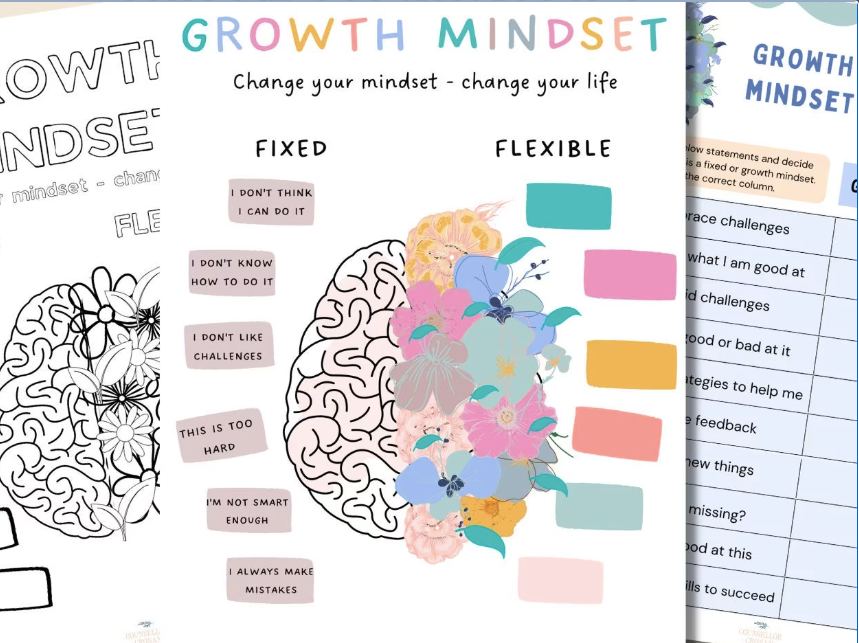
This activity involves completing a worksheet that prompts kids to reflect on their beliefs and attitudes related to growth and fixed mindsets.
How to do it:
- Provide kids with a worksheet, which can include questions and prompts related to their mindset or beliefs.
- Encourage them to complete the worksheet independently or with guidance.
- Ask them to answer questions about their reactions to challenges, how they handle mistakes, and their views on learning and effort.
How it helps:
- These growth mindset worksheets serve as a structured self-assessment tool, helping kids identify areas where they may hold fixed mindset beliefs.
- It prompts critical thinking and self-awareness, allowing kids to recognize the importance of cultivating a growth mindset in various aspects of their lives.
3. The Growth Mindset Story Narration

The growth mindset book club is a group activity where children read books featuring characters with growth mindsets and discuss the character’s journey.
How to do it:
- Choose age-appropriate books that have characters facing challenges, making mistakes, and learning from them.
- Set up regular book club meetings where kids can discuss the characters’ growth journeys and how they relate to their own experiences.
- Encourage them to share their thoughts, questions, and insights.
How it helps:
- The growth mindset book club introduces kids to growth mindset resources in the form of literature.
- It fosters critical thinking and empathy as they analyze characters’ responses to challenges, helping them apply those lessons to their own lives.
4. Growth Mindset Story Cubes
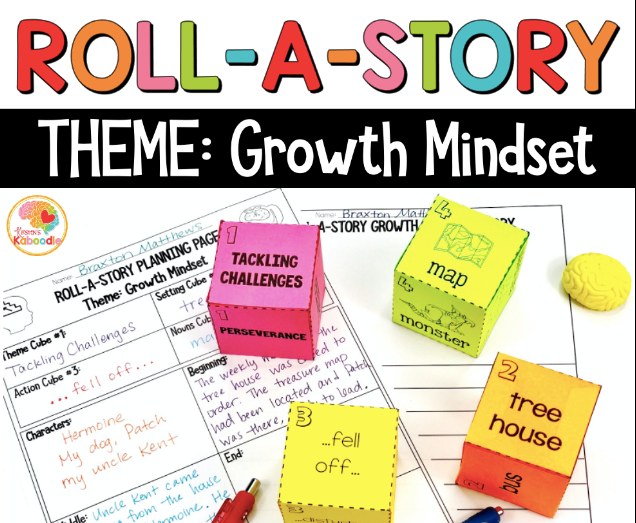
Story cubes are used to spark creativity and storytelling, and in this activity, they are infused with growth mindset themes.
How to do it:
- Create or purchase story cubes with images or words related to growth mindset (e.g., obstacles, effort, resilience).
- Roll the cubes and ask kids to use the images or words to create a story that illustrates the importance of a growth mindset.
- Encourage them to incorporate challenges and perseverance into their narratives.
How it helps:
- Growth mindset story cubes enhance creativity and storytelling skills.
- This activity helps kids practice framing challenges as opportunities for growth and demonstrating the power of effort and resilience in storytelling.
5. Obstacle Course Challenge
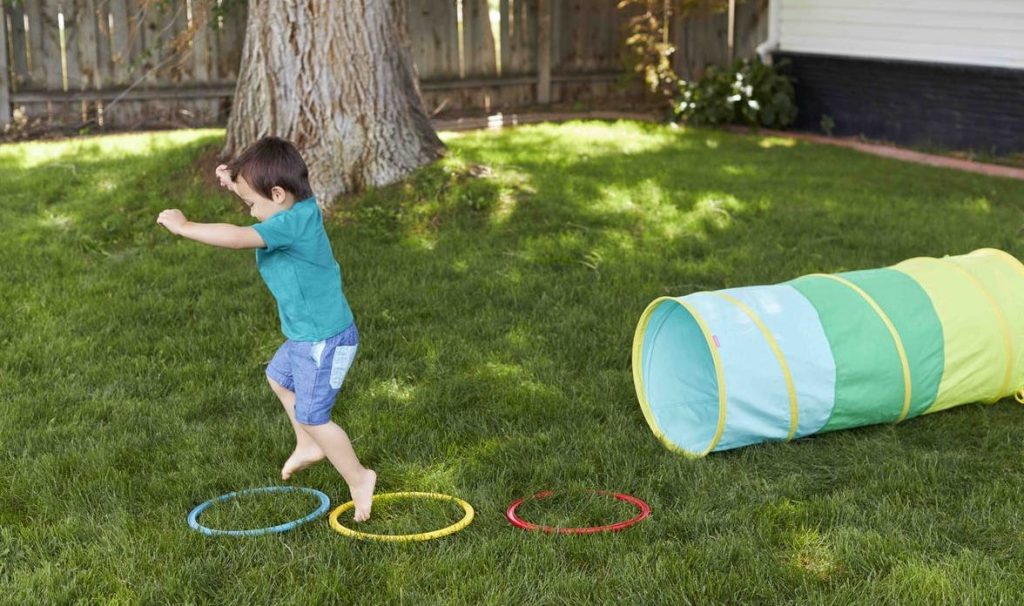
Kids engage in a physical obstacle course that requires problem-solving and persistence.
How to do it:
- Set up an obstacle course using household items like cushions, boxes, and hula hoops.
- Create challenges within the course, such as crawling under tables or balancing on one foot.
- Time the participants as they complete the course and encourage them to improve their times by applying different strategies.
How it helps:
- The obstacle course challenge is an active growth mindset exercise that teaches kids to approach physical and mental obstacles with determination.
- It promotes problem-solving skills, resilience, and the idea that challenges can be fun opportunities to learn and grow.
6. Goal Achievement Charts
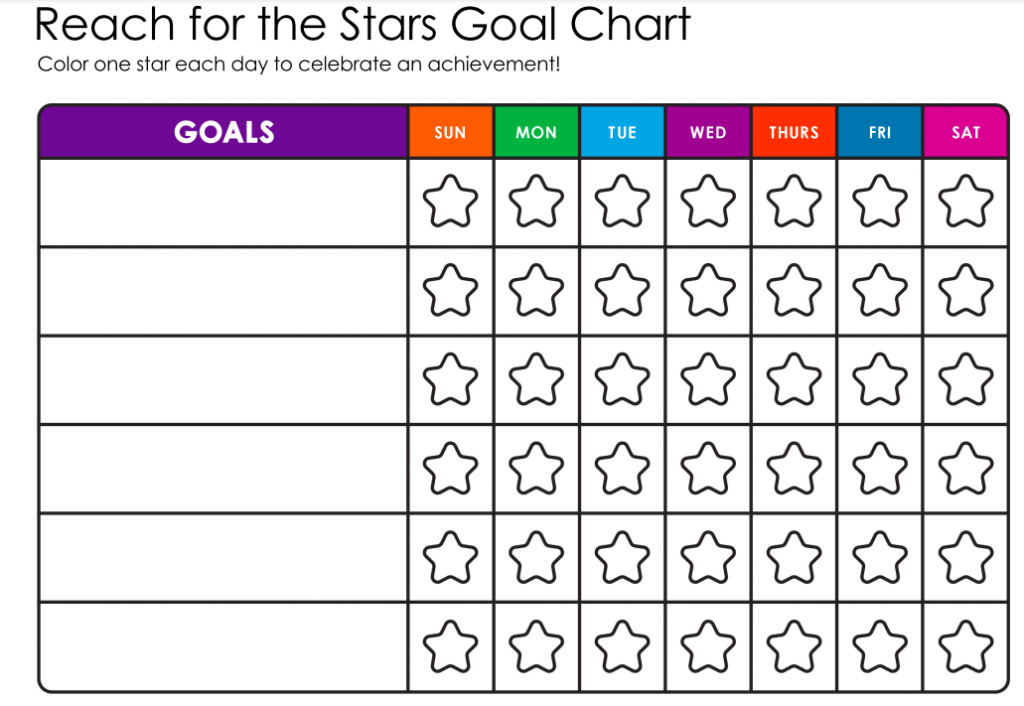
This activity involves creating charts to track progress toward specific growth mindset goals or habits.
How to do it:
- Provide kids with blank charts or templates with columns for tracking daily or weekly progress.
- Have them set specific goals related to areas they want to improve or develop a growth mindset.
- Encourage them to use stickers or markers to mark off each day they make progress toward their goals.
How it helps:
- Goal achievement charts provide a visual representation of progress, helping kids see the tangible results of their efforts.
- They reinforce the concept that consistent effort and perseverance lead to growth and achievement.
7. Growth Mindset Coloring Book
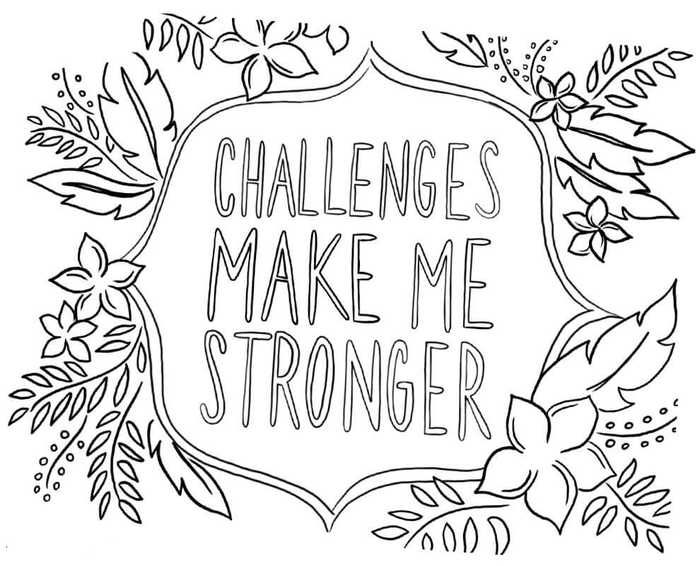
Kids can create their own coloring book filled with growth mindset illustrations and inspirational quotes.
How to do it:
- Provide blank sheets of paper or a printable coloring book template.
- Encourage kids to draw or find growth mindset-related images and design coloring book pages.
- Add inspirational quotes or phrases to each page.
- Once completed, they can color in their illustrations.
How it helps:
- The growth mindset coloring book combines creativity and reflection.
- It provides a calming and artistic way to reinforce the importance of positive thinking and perseverance.
8. Positive Post-It Notes
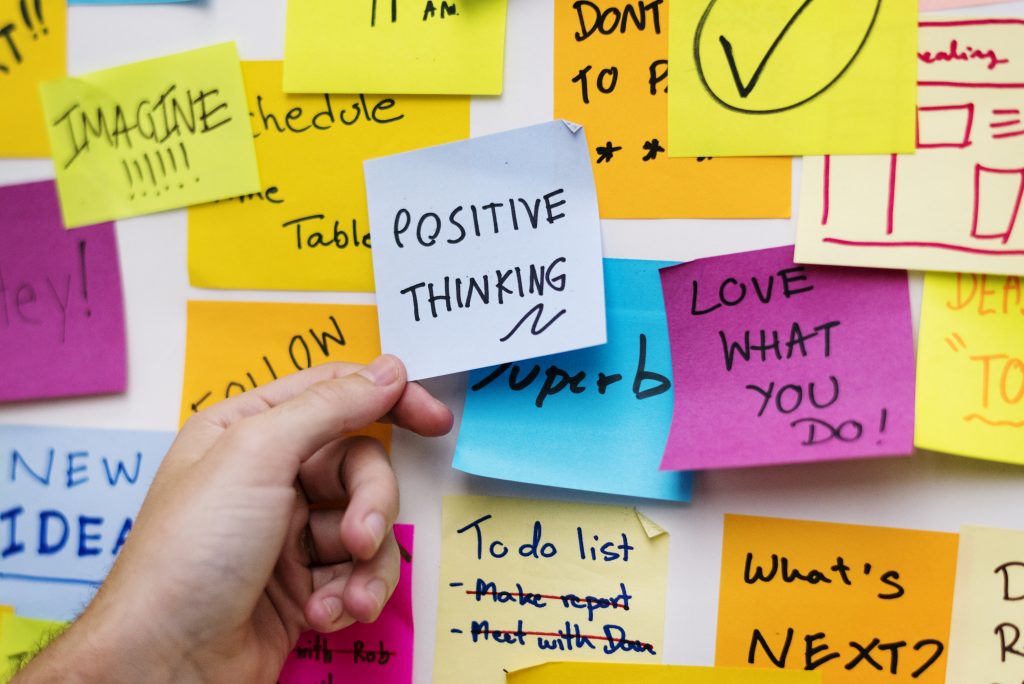
This activity involves creating and placing positive affirmations on sticky notes in visible locations.
How to do it:
- Provide kids with colorful sticky notes and markers.
- Have them write positive affirmations related to a growth mindset (e.g., “I can learn from mistakes,” “I embrace challenges”).
- Encourage them to place these notes where they’ll see them daily, such as on a mirror, bedroom door, or school binder.
How it helps:
- Positive post-it notes serve as daily reminders of growth mindset ideas, reinforcing a positive self-perception.
- They help kids develop a habit of positive self-talk and cultivate a more optimistic outlook on challenges and setbacks.
9. Growth Mindset Art Gallery
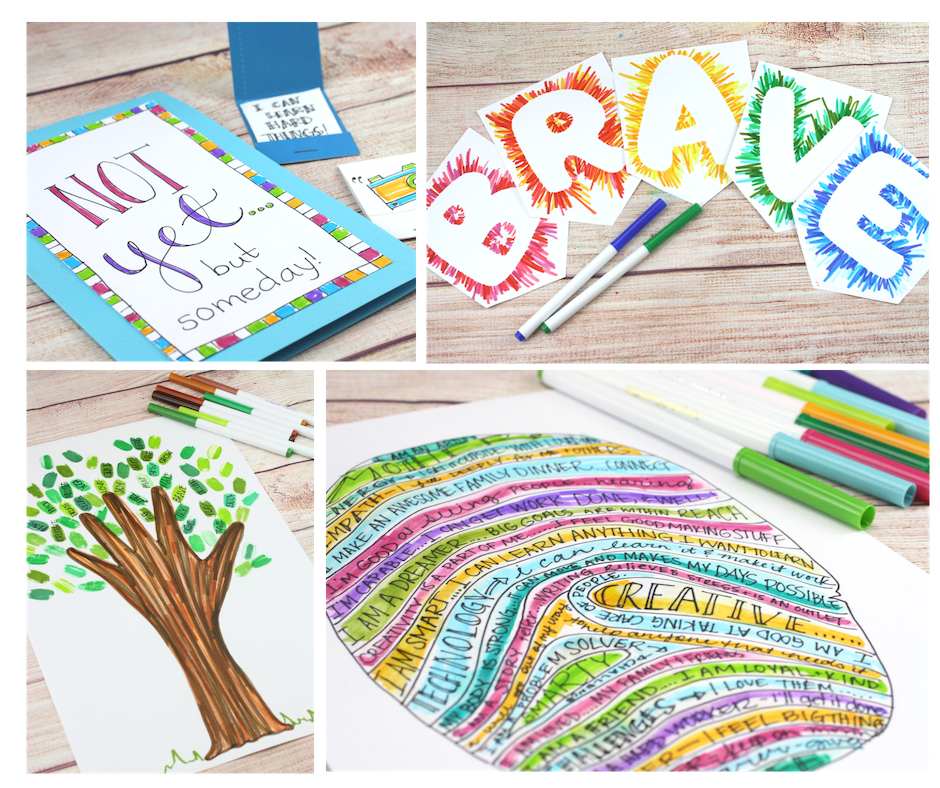
This activity involves organizing an art exhibition where kids display their growth mindset-themed artwork.
How to do it:
- Assign a theme or topic related to growth mindset (e.g., resilience, learning from mistakes).
- Have kids create artwork, such as paintings, drawings, or sculptures, that reflects the chosen theme.
- Set up an exhibition space where they can showcase their creations, inviting others to view and discuss the art.
How it helps:
- The growth mindset art gallery encourages self-expression and creativity.
- It provides an opportunity for kids to share their perspectives on resilience and learning through art, fostering a sense of accomplishment.
10. Mistake Reflection Journal
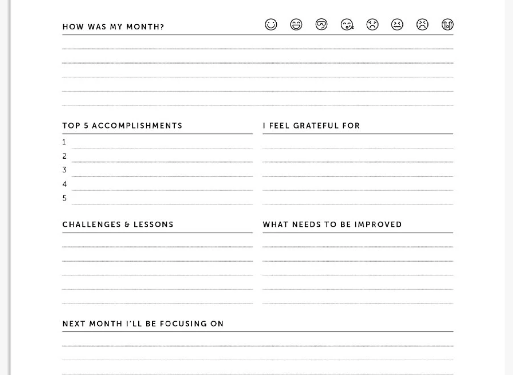
In this activity, kids keep a journal to reflect on their mistakes, what they learned, and how they plan to improve.
How to do it:
- Provide kids with a notebook or journal designated for mistake reflection.
- Encourage them to write about recent mistakes they’ve made, describing the situation and their initial reactions.
- Ask them to reflect on what they learned from the mistake and what strategies they can use to avoid it in the future.
How it helps:
- The mistake reflection journal promotes self-awareness and a growth mindset by encouraging kids to view mistakes as opportunities for learning.
- It helps them develop problem-solving skills and resilience as they analyze and plan for improvement.
11. Growth Mindset Word Search
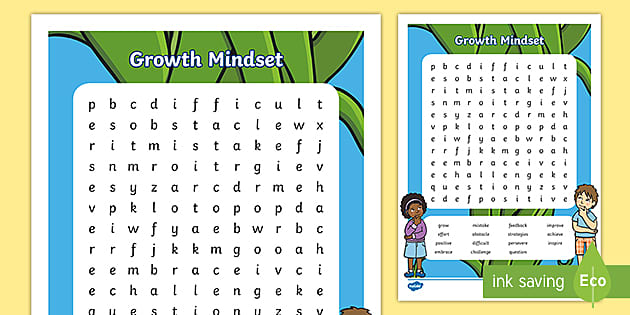
This activity involves creating and solving word search puzzles with growth mindset-related words.
How to do it:
- Design or find a growth mindset word search puzzle.
- Provide kids with the puzzle and a list of words to find (e.g., perseverance, effort, resilience).
- Have them search for the words within the grid and mark them off as they find each one.
How it helps:
- Growth mindset word search reinforces growth mindset vocabulary and concepts in an engaging and interactive way.
- It enhances word recognition and critical thinking skills while promoting a deeper understanding of growth mindset terminology.
12. The Growth Mindset Story-weaving Game

This activity involves a storytelling game where participants collaboratively create a story with growth mindset themes.
How to do it:
- Gather a group of kids in a circle.
- Begin a story with a growth mindset theme (e.g., a character facing a challenge).
- Each participant takes turns adding a sentence to the story, building upon the previous contributions.
- Encourage creativity and exploration of growth mindset within the narrative.
How it helps:
- The growth mindset storytelling game enhances creativity and teamwork as kids work together to construct a story.
- It reinforces the concept of growth mindset by weaving growth-related themes into the storytelling process.
13. Growth Mindset Treasure Hunt
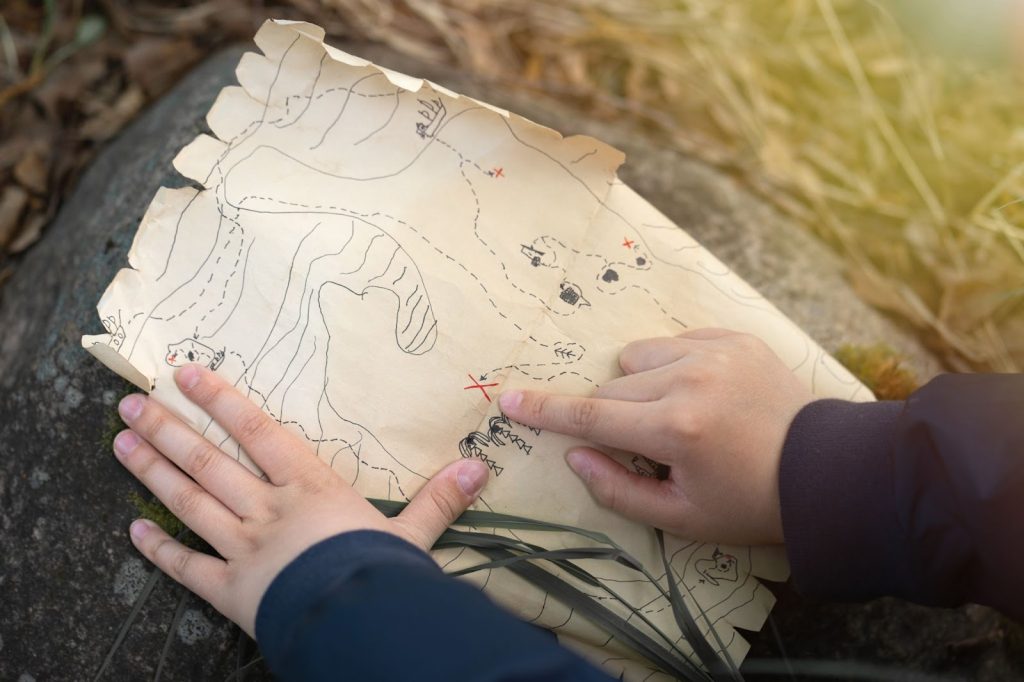
This activity involves organizing a treasure hunt where kids follow clues, work together, and overcome obstacles to find hidden treasures.
How to do it:
- Create a set of clues and riddles related to growth mindset concepts and challenges.
- Hide the clues throughout a designated area (e.g., a park, school, backyard).
- Divide kids into teams and provide them with the first clue.
- As they solve each clue, it leads them to the next one until they find the hidden “treasure.”
How it helps:
- The growth mindset treasure hunt combines teamwork and problem-solving.
- It encourages kids to embrace challenges and persist in the face of obstacles, fostering a sense of accomplishment when they find the treasure.
Related Reading: Best Scavenger Hunt Ideas for Kids
14. Daily Growth Mindset Challenge Cards
This activity involves creating a deck of cards, each with a daily growth mindset challenge or task for kids to complete.
How to do it:
- Design or print daily challenge cards with growth mindset activities (e.g., try something new, learn from a mistake, help a friend overcome a challenge).
- Place the cards in a container.
- Each day, have kids draw a card and complete the challenge specified on it.
How it helps:
- Daily growth mindset challenge cards provide a daily dose of growth mindset exercises and encourage kids to practice growth-oriented behaviors.
- They reinforce the idea that small actions can contribute to a growth mindset and personal development.
15. Growth Mindset Debate
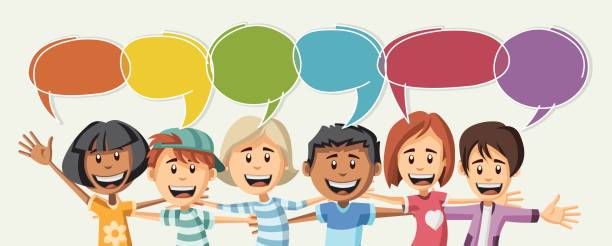
This activity involves kids debating various topics related to growth vs. fixed mindsets, helping them articulate and defend their understanding.
How to do it:
- Propose a statement related to growth mindset (e.g., “Effort is more important than talent”).
- Divide kids into two groups: one in favor of the statement and one against.
- Allow each side to present their arguments, followed by a discussion.
How it helps:
- Debating allows kids to critically think about growth mindset concepts and defend their understanding.
- It fosters communication skills and the ability to see multiple perspectives on a topic.
Related Reading: Interesting Debate Topics for Kids of All Ages & Grades
16. Growth Mindset Affirmation Jar
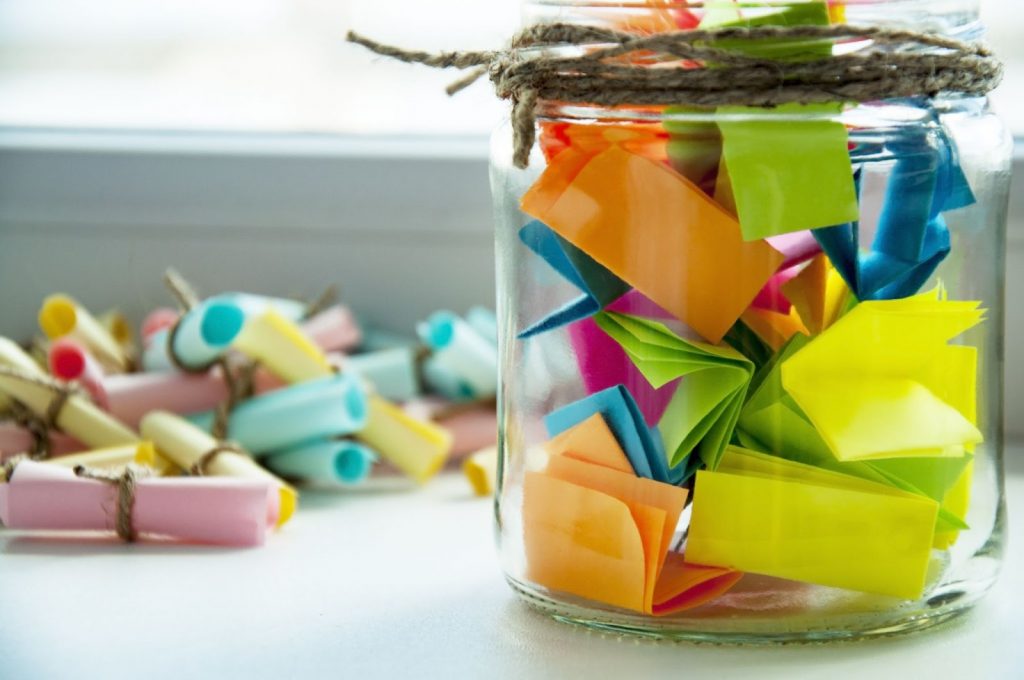
This activity involves creating a jar filled with growth mindset affirmations that kids can pull out and read whenever they need a boost.
How to do it:
- Provide kids with colorful strips of paper and pens.
- Encourage them to write down growth mindset affirmations (e.g., “I am capable of learning new things,” “Challenges help me grow”).
- Once written, fold the strips and place them in a jar.
- Whenever they need encouragement, they can pull out an affirmation and read it aloud.
How it helps:
- The affirmation jar serves as a constant source of positive reinforcement.
- It reminds kids of their potential and the power of a growth mindset.
17. Growth Mindset Discussion Cards
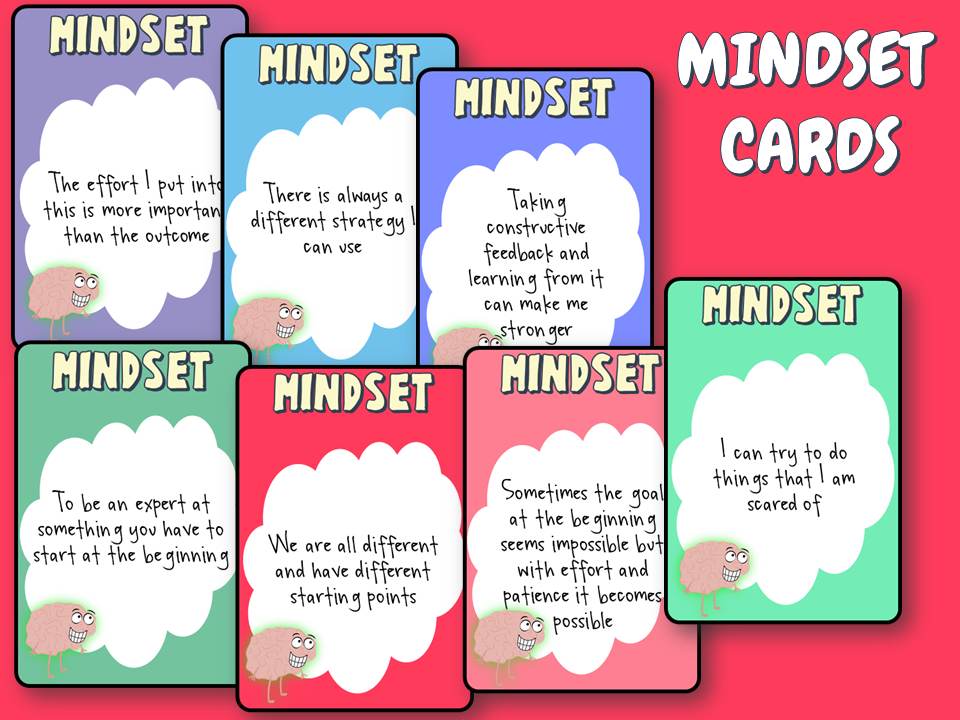
This activity involves creating discussion cards with growth mindset topics to facilitate conversations and reflections.
How to do it:
- Design or print discussion cards with growth mindset prompts (e.g., “Describe a time you faced a challenge and didn’t give up,” “Share a mistake you made and what you learned from it”).
- Gather a group of kids and distribute the discussion cards.
- Encourage them to take turns answering the prompts and engaging in discussions about their experiences.
How it helps:
- Growth mindset discussion cards stimulate meaningful conversations about growth mindset ideas, challenges, and achievements.
- They provide a structured way for kids to share their stories and learn from each other’s experiences, promoting empathy and growth-oriented thinking.
- These activities offer dynamic ways for kids to actively engage with growth mindset concepts, whether through treasure hunts, daily challenges, or creative word art, fostering teamwork, creativity, and discussion while reinforcing the importance of effort and resilience.
Related Reading: Best Scavenger Hunt Ideas for Kids Paired With Themes
Conclusion
Helping kids develop a growth mindset is like giving them a superpower for life. By embracing these growth mindset activities, children learn that they can conquer challenges, learn from their mistakes, and become better with every effort. It’s about turning “I can’t do it” into “I can’t do it yet” and watching them thrive. So, whether it’s creating vision boards, solving puzzles, or sharing their mistakes, these activities plant the seeds of confidence, resilience, and a lifelong love for learning. Let’s empower our kids to embrace growth and become unstoppable learners, because with a growth mindset, they can achieve anything they set their minds to!
Related Reading: Amazing Writing Prompt For Kids To Improve Confidence
Frequently Asked Questions (FAQs)
What age group are these growth mindset activities suitable for?
These activities can be tailored to various age groups, from young children to teenagers, with adjustments in complexity and guidance based on individual development levels.
Can these activities be used in a classroom setting for growth mindset lessons?
Many of these activities are adaptable for classroom use and can enhance a positive learning environment by promoting a growth mindset among students. Incorporating these growth mindset activities for students regularly can lead to meaningful lessons and lasting mindset shifts.
How often should we engage in these activities for meaningful results?
Consistency is key. Incorporating growth mindset activities regularly, such as once or twice a week, can yield meaningful results over time, reinforcing the mindset shift we aim to instill in children.

















